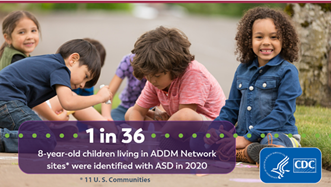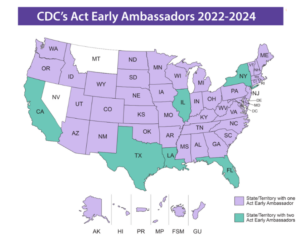Paige Falion, MS, Associate Director, Child Health and Children & Youth with Special Health Care Needs, Association of Maternal & Child Health Programs (AMCHP)
 On March 23, 2023, the Centers for Disease Control and Prevention (CDC) released the latest prevalence estimate of autistic children[1] in the United States. The data show that the March 2023 estimate of 1 in 36 8-year-old children is higher than the previous estimate published in December 2021 of 1 in 44 8-year-old children. The report shows rates of diagnosis continue to rise as the features of autism are better recognized and partners continue to work harder to reduce racial and gender disparities in diagnosing autism. However, public health researchers, clinicians, and policymakers all must work together alongside autistic people to do more to address the remaining disparities in who gets diagnosed and to ensure autistic people in all communities receive the support they need to thrive.
On March 23, 2023, the Centers for Disease Control and Prevention (CDC) released the latest prevalence estimate of autistic children[1] in the United States. The data show that the March 2023 estimate of 1 in 36 8-year-old children is higher than the previous estimate published in December 2021 of 1 in 44 8-year-old children. The report shows rates of diagnosis continue to rise as the features of autism are better recognized and partners continue to work harder to reduce racial and gender disparities in diagnosing autism. However, public health researchers, clinicians, and policymakers all must work together alongside autistic people to do more to address the remaining disparities in who gets diagnosed and to ensure autistic people in all communities receive the support they need to thrive.
The Autism and Developmental Disabilities Monitoring (ADDM) Network
Established in 2000, the ADDM Network is the only network that tracks the number and characteristics of children with autism and other developmental disabilities in multiple communities throughout the United States. Since the launch of the ADDM Network in 2000, CDC has funded 17 sites. Sites are located in Alabama, Arizona, Arkansas, California, Colorado, Florida, Maryland, Minnesota, Missouri, New Jersey, North Carolina, Pennsylvania, South Carolina, Tennessee, Utah, West Virginia, and Wisconsin. CDC also operates an additional ADDM site in Georgia.
The ADDM Network links information from multiple sources in the community. It uses population-based methods to identify all children with autism spectrum disorder (ASD) from the entire population of children in defined geographic areas and it tracks changes over time within different groups (such as racial/ethnic groups). The ADDM Network is following up on a cohort of 16-year-old children in select states. Learn more about the ADDM sites here.
Overview of the Updated Findings (in March 2023)
- Increased prevalence estimate. One in every 36 children had autism. This increase is likely due to better recognition of the signs of autism and increased diagnosis across the United States. The implication is that diagnosis rates will continue to rise as professionals continue to focus on addressing diagnostic disparities and improving access to diagnosis and support.
- Racial and Ethnic Disparities. For the first time since the start of the ADDM study, people of color were identified with greater frequency than White people. This likely reflects long-term efforts to reach communities of color and improve access to early identification and services. However, some diagnostic disparities remain and continue to be an issue for autistic people of marginalized races, ethnicities, and genders. Researchers, clinicians, and policymakers must continue to collaborate to end these disparities and remove bias from the diagnostic process.
- Time of identification. Children born in 2016 were 56 percent more likely to receive an autism diagnosis by age 4 compared with children born in 2012. The earlier a child can be identified as having autism, the sooner the child can receive services and support. Improvements in obtaining early identification make it even more critical that parents receive accurate, non-stigmatizing information about autism when their children are diagnosed. These services can help the child develop important skills in childhood and as they become adolescents and adults.
- Disruptions to early identification at the onset of COVID-19. An analysis compared the number of ASD evaluations and identifications before and after the onset of the COVID-19 pandemic. It found that before the pandemic, 4-year-old children were receiving more evaluations and identifications than 8-year-old children did when they were 4 years of age. However, these improvements in detecting and evaluating ASD were halted beginning in March 2020. Delays in identifying autistic children and initiating services for them during the COVID-19 pandemic can have unintended long-lasting negative effects.
- Older autistic populations. Earlier this year, for the first time, the ADDM study included information about diagnoses, support needs, and transition planning into adulthood for adolescents up to the age of 16 for five ADDM locations. It is critical to follow autistic individuals and understand their experiences across the lifespan and through adulthood. Systems of care must understand how autistic people’s support needs change as they develop and age.
How to Access the Report and Associated Findings
The website (https://www.cdc.gov/ncbddd/autism/new-data.html) features the 2023 community report, updated fact sheet, and summarizes key findings in plain language.
Set out below are links to the full surveillance summary reports:
The Role of MCH Professionals in Staying Informed and Addressing Continued Disparities
MCH professionals, including Title V staff, early childhood and school system staff, health care organizations, researchers, and policymakers, can use ADDM Network findings to support service planning, inform policies that promote improved outcomes in health care and education, guide research on risks and protective factors for ASD, and promote interventions that can help autistic children succeed. Public health professionals, such as community health workers and epidemiologists, can benefit from evaluating the impact of disruptions to children who may have experienced delays in getting evaluated and identified for ASD so they can develop strategies to lessen service disruptions and longer-term negative effects during public health emergencies.

Figure 1. Locations of CDC’s Act Early Ambassadors 2022- 2024.
Early identification remains a major focus of CDC’s ADDM Network, because it is one of the most important tools communities can use to make a difference in the lives of autistic children. Title V and other MCH professionals should keep informed of CDC’s continuous tracking of ASD and other developmental disabilities, especially in states that have funding for an ADDM site and also states and jurisdictions that have selected Title V National Performance Measure 6 on Developmental Screening as a priority. In addition, the CDC’s Learn the Signs. Act Early. program promotes early identification by providing parents, child care professionals, and health care providers free resources, in English and Spanish, so they can monitor children’s development. (See Figure 1, which shows the states and territories that have ambassadors for this program.) We encourage all state Title V programs to familiarize themselves with the Learn the Signs. Act Early. program, its materials, and the role of the Learn the Signs. Act Early. Ambassadors who serve as a state or jurisdiction point-of-contact for the national “Learn the Signs. Act Early.” program.
AMCHP’s State Public Health Autism Resource Center (SPHARC) can connect state Title V programs with ADDM sites in their state as well as their Act Early Ambassador to discuss collaboration opportunities. We know that many Title V programs are already well acquainted with their Act Early Ambassador. However, we want to ensure all states have access to this vital program, which has proven success in monitoring children’s development. For more information about facilitating a connection, please contact the SPHARC team at SPHARC@amchp.org.
[1] AMCHP recognizes that when referring to autistic people, a one-size-fits-all approach is not the answer. AMCHP is fortunate to co-design our autism programming with our Autistic Faculty at the State Public Health Autism Resource Center (SPHARC). These staff have enlightened us about using identity-first language as a way to lift up the joy of being neurodivergent. As a result, AMCHP has recently shifted to using “autistic people” consistently in our writing and communications.
